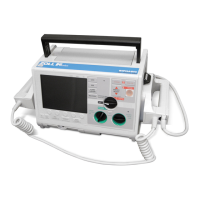NON-INVASIVE BLOOD PRESSURE (NIBP)
8 ZOLL M Series Operator’s Guide - Option Insert
NOTE The following procedures assume that you are already in the NIBP menu.
Selecting the Patient Type (CCT units only)
On M Series CCT units, you can select a patient type for NIBP measurements: adult, pediatric, or
neonate. The patient type setting determines the default cuff inflation pressure, as well as alarm limits
for high/low systolic, diastolic and mean blood pressure values.
Unless configured otherwise, the M Series CCT unit defaults to adult patient mode when initially
powered on. See the M Series Configuration Guide for more information.
NOTE When you change the patient type setting, the unit clears any currently displayed NIBP values from
the LCD. You must reinitiate NIBP measurement to display new blood pressure values.
To change the Patient Type setting:
1. Press the NIBP PT. Type softkey from the NIBP menu. If the NIBP PT. Type softkey label is not
displayed, see "Displaying the NIBP Menu" on page 7.
The M Series displays the NIBP Patient menu:
Figure 6 NIBP Patient Menu
2. Press the NIBP Adult, NIBP Ped, or NIBP Neonate softkey to select the appropriate patient type
setting.
The M Series CCT unit displays a Patient Type indicator in the NIBP display area (“P” for
pediatric mode, or “N” for neonatal mode), and automatically updates the default cuff inflation
pressure and default alarm settings accordingly.
NOTE If you press the Return softkey, the M Series CCT unit returns to the NIBP menu without
changing the patient type setting.
WARNING Do not begin NIBP measurements unless the patient mode setting is appropriate for the patient. Taking
NIBP measurements on a pediatric or neonatal patient while the unit is in adult mode can result in
inaccurate measurements and injury to the patient. Taking NIBP measurements on an adult patient
while in pediatric or neonatal mode can result in inaccurate measurements.
Selecting Cuff Inflation Settings
Before taking a measurement, ensure that the cuff inflation settings are appropriate for the patient. To
measure a patient’s blood pressure, the cuff must begin the measurement cycle by inflating to a
pressure higher than the patient’s systolic blood pressure. This value is called the cuff inflation
pressure. During a NIBP measurement, the M Series unit may increase the cuff inflation pressure over
the initial value to obtain a systolic reading.
By default, the cuff inflation pressure for the first measurement after power-up is set as follows:
• 160 mmHg (21.3 kPa) for adult mode
• 120 mmHg (16.0 kPa) for pediatric mode (CCT units only)
• 90 mmHg (12.0 kPa) for neonatal mode (CCT units only)
Use the default settings unless they are clearly inappropriate. Any changes to these settings remain in
effect until either the settings are changed or 10 seconds after the M Series unit is turned off (returning
the settings to their defaults). See the M Series Configuration Guide for information on reconfiguring
the cuff inflation pressure default setting.
NIBP
Ped
NIBP
Adult
Return
NIBP
Neonate

